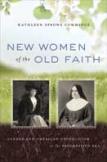Our Founding Mothers
When I opened this fascinating book by Kathleen Sprows Cummings, I was not sure what to expect. The cover shows two women at the turn of the 20th century, one in a religious habit, the other dressed as a materially comfortable woman. What could these two women possibly have in common? The answer is: much more than you would imagine.
New Women of the Old Faith explores a piece of American Catholic history that is often overlooked. Cummings chronicles the lives and work of four American Catholic women who, while being faithful members of the pre-Vatican II Catholic Church, were powerful advocates for Catholic women trying to break into American society and find their own voice alongside the “New Woman” movement. The four women chronicled are Margaret Buchanan Sullivan (d. 1903), an ardent Irish nationalist and prolific Catholic writer; Sister Julia McGroarty, S.N.D. (d. 1901), American provincial superior of the Sisters of Notre Dame de Namur and founder of Trinity College for Catholic Women; Sister Assisium McEvoy, S.S.J. (d. 1939), a Philadelphia educator who figured greatly in the expansion and consolidation of the Catholic education system locally and nationally; and Katherine Eleanor Conway (d. 1927), a Boston journalist, editor and public figure. Each of these women is noteworthy in her own right, and each was dedicated to improving the lives of Catholic women while encouraging them to resist the promises of the newly emerging secular women’s organizations.
As explained by Cummings, Henry James coined the phrase “New Woman” to describe wealthy widows living abroad. The movement came to represent women who felt trapped and constricted by Victorian society and who desired to break from traditional domestic rules. This secular movement greatly alarmed Catholics who saw it as a threat to single Catholic women, who were expected to play a part in their church community and be faithful to the roles assigned them by “Mother Church.” There was also the fact that the “New Woman” movement was significantly Protestant. At this time in U.S. Catholic history the American Protestant was the enemy. All four of the featured women in this book believed that American Catholic women at the turn of the century would truly “liberate” themselves if they found women to emulate from their own faith tradition, such as St. Catherine of Siena, St. Jane Frances de Chantal and St. Elizabeth Ann Seton. It would be Catholic teaching, as opposed to the suffragette movement, that would show Catholic women the way to live their lives. And of course, it would be through education that Catholic women would truly achieve full personhood.
This book will be of special interest to anyone who has spent time in the field of Catholic education, especially in Catholic higher education. As Cummings explains, the story of the founding of Trinity College in Washington, D.C., is a marvelous example of how “U.S. Catholic women enlarged their lives during the Progressive Era.” One cannot help but be impressed by the tenacity and vision of Sister Julia McGroarty, who “dared” to found a college without a preparatory academy already in place and also without any assurance of monetary backing. The stories of the Philadelphia S.S.J.’s and I.H.M.’s only adds to the truth that women religious during the Progressive Era let nothing come between them and their desire to build a Catholic school system in America.
Their efforts were supported by women like Margaret Sullivan and Katherine Conway, who believed wholeheartedly in church-sponsored education for women. These two laywomen had an impact on the lives of their Catholic “sisters” in a manner different from that of women religious. Their writing and journalistic abilities, along with their personal friendships with members of the hierarchy, opened doors for them that would always remain closed to the sisters. While they did not support the “New Woman” movement, they understood that Catholic women needed a strong faith life and a somewhat independent spirit.
There is a noticeable tension in the book between the fact that American women at the start of the 20th century did not have rights owed them as fully human beings, such as the right to vote, and a Catholic vision of what it meant to be a truly liberated American woman. The two laywomen featured in this book only grudgingly accepted the 19th Amendment, which gave women the right to vote. I wanted Cummings to spend more time analyzing whether the refusal of the Catholic Church and specific women in the church to support more secular reform movements served to alienate Catholic women from social reform activities in the middle of the century and up to our day.
Cummings refers to the journalist Anna Quindlen and to Helen Prejean, C.S.J., as examples of dedicated Catholic women who are modern counterparts to the four women featured in this book. But she labels the first as one with outspoken views on issues like abortion and the second as one who does not wear the more traditional habit. They are portrayed as women “on the fringe” rather than Catholic women who genuinely influence others today. I wonder whether the fact that certain influential Catholic women of the early 20th century resisted secular social movements has impeded post-Vatican II Catholic women from responding energetically to the women’s rights movement, racial issues and other social problems.
New Women of the Old Faith will assuredly appeal to anyone interested in the story of American Catholicism and the growth of the American immigrant church. It offers a fresh perspective on the struggles Catholic women faced as they tried to become good citizens of these United States while also being good daughters of the Catholic Church. The struggle was not always easy, and still is not today. But as Cummings points out, Catholic women are creative, dedicated, bright and visionary people. These qualities served us well in the past and will do so in the future.
This article also appeared in print, under the headline “Our Founding Mothers,” in the November 9, 2009, issue.








